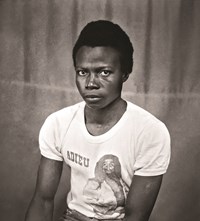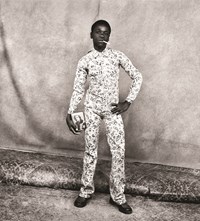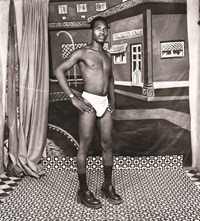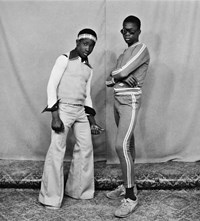Explore the life and work of Sory Sanlé, who documented the cultural revolution of a newly independent Burkina Faso – plus, preview a new book of his photography
- TextDaisy Woodward
The 1960s and 70s marked a golden era for Burkina Faso. The landlocked West African country, then known as the Republic of Upper Volta, gained independence from France in 1960, sparking a cultural revolution as its people sought to re-establish a collective identity, fusing ancient tradition with a new sense of modernity. The city of Bobo-Dioulasso was at the centre of this renaissance, boasting a burgeoning economy and vibrant music scene. It was here that a young photographer named Sory Sanlé had arrived some years earlier from the countryside, determined to escape his destiny as a farm worker. He had first apprenticed for a Ghanaian photographer, before setting up his own studio in the spring of 1960, with the help of an entrepreneur cousin – just in time to capture history in the making.
Sanlé was blessed with a shrewd eye, a gift for making others feel at ease and an excellent work ethic. He would spend every weekday from 7am until 8pm in the studio before heading out into Bobo-Dioulasso to capture its streets, its music and its people by night, compiling an extraordinary portrait of the city. By the mid-1970s, Sanlé’s studio, Volta Photo, had gained a reputation as the go-to destination for studio portraits – but internationally the photographer remained unknown. In 2011, however, some 50 years after Sanlé first set up shop, French author and record producer Florent Mazzoleni stumbled across his work while researching a book about West African music, noticing that many Upper Volta record sleeves bore compelling portraits by Sanlé. A bit of digging unearthed the address of the still-active image-maker’s studio and, intrigued, Mazzoleni decided to pay Sanlé a visit.
“The first time I met Sory, he was standing outside his studio burning negatives,” Mazzoleni tells Another Man over the phone. “He told me they were old and didn’t resonate with people any more.” Happily, Mazzoleni convinced him otherwise, and thereafter the pair embarked on a journey to bring the photographer’s work (encompassing “hundreds of thousands of negatives”) to a wider audience. Last year Mazzoleni produced a boxset of Upper Volta music, alongside a photo-book of Sanlé’s extensive documentation of the country’s musical past, while next month will see the now-75-year-old’s first solo exhibit open in London, comprising around 40 studio and street shots taken between 1965 and 1985, alongside the launch of an accompanying photo-book, published by Reel Art Press.
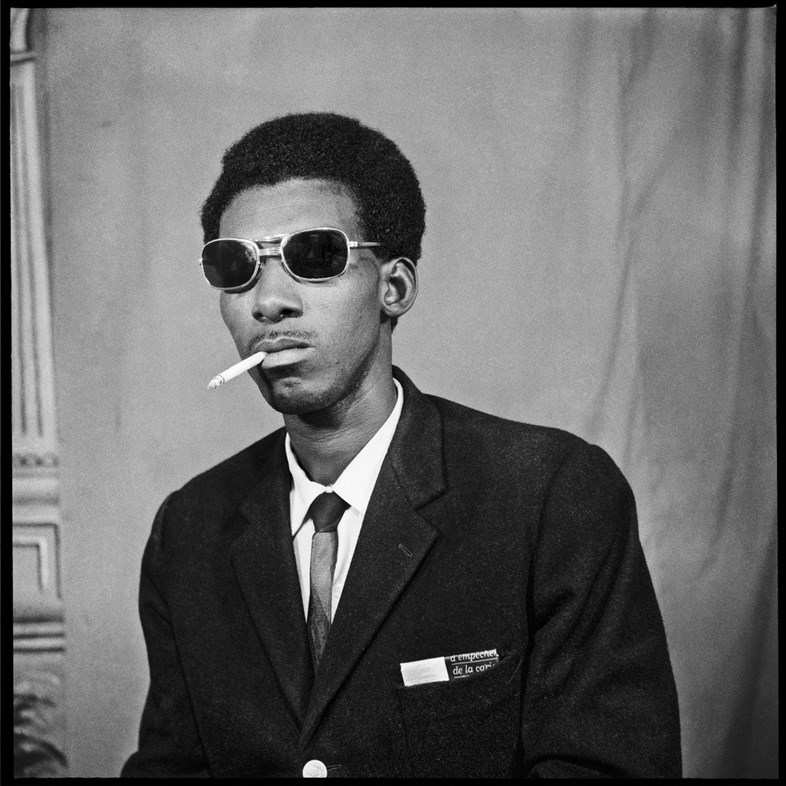
In the studio, Mazzoleni tells us, Sanlé’s approach was brilliantly simple: he would greet whoever walked through his door with an array of props to choose from, from cigarettes, sunglasses and suits to record players and radios, and in the 1970s also began offering a range of backdrops for his clients to stand against – spanning a beachscape, a city street and an aeroplane. As a result, his sitters frequently adopted an air of theatrical confidence, to joyful effect. “The 60s and 70s were a time when everything felt possible,” notes Mazzoleni. “They were the happy times for Burkina Faso’s people and Sory’s photos were a way for them to dream big. He captured the smiling reality of the time; not the images people might expect of war and poverty.”
“Sory makes everyone he meets feel comfortable,” Mazzoleni observes of Sanlé’s ability to extract such candid responses from his subjects. “His studio was tiny but really lively. People from all walks of life would come in because his prices were affordable; it was a very democratic process. There is a quote by the filmmaker Jean Renoir that applies so well to Sory’s work: ‘the more local, the more universal’. He documented his own people in Burkina Faso but he ended up making a perfect universal statement. He’s amazed that his work can steal some interest, but if it wasn’t for him I don’t think there’d be any documentation of this unique time.”
Sory Sanlé – Volta Photo 1965-85 is out in September, published by Reel Art Press, and an accompanying exhibition will be at Morton Hill Gallery from September 14 – October 27.
